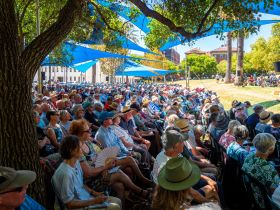In recent days we have witnessed the public crowding retail outlets and malls, as the first easing of COVID-19 restrictions have come into play. It is a bitter sweet sight. For many, the hankering for “retail entertainment” is greater than the social responsibility to uphold distancing and hygiene measures to overt a potential second wave of the pandemic.
The key here is trust. Are we willing to trust others – to trust venues – to ensure we don’t have a second lockdown?
Arts and cultural venues are yet to receive the green light for opening their doors, largely falling under Step Two in the National Cabinet’s roadmap to recovery, and mooted by most states to happen early-mid June.
Read: What ScoMo’s lifted restrictions mean for the arts sector
The arts aren’t adverse to the risks upon reopening, so how do organisations build trust into their re-opening strategy? And what are the measures that they need to take to ensure they have the support of visitors, once the doors are open?
CONQUERING FEAR IN YOUR REOPENING STRATEGY
At this early stage, it is unclear the impact the lockdown will have on people’s visiting behaviours moving forward. Some believe they will be cautious and take on today’s new lessons; others believe too quickly people will slip back into their old routines.
The truth is, in Australia we are still looking at several months of adjusted behaviour – both financial and physical. Fear is not exclusive to our health; there is the fear of surviving as an organisation.
Without financial support commensurate with the loss within the sector, one of the first jobs in a reopening strategy is to reappraise your organisation’s business model.
What can you still manage – financially – to deliver? Where are the quickest wins to stimulate income? Is it simply too costly to open with reduced audience numbers? And is staying closed in this first wave, the better option for greater sustainability?
They are tough questions, and ones that need to be answered well before ordering the hand-sanitiser and whacking a celebratory post on Instagram.
From an organisational perspective, one of the greatest fears faced by a CEO, General Manager or Director is their duty of care for their staff. Some organisations were forced to stand down staff; others had the option to redeploy staff to different departments. Your reopening strategy must address how you will strategically reinstate your team, and to reassure them against the fear of this happening again.
This new world also requires new duties. Does your strategy require hiring additional janitors and cleaning services? While your visitor numbers will be down, your assurance of a healthy venue to patrons is just as key to your organisations future sustainability. And, where will the money come from for this additional staff?
Volunteers also play a key role in an organisation’s smooth operations. However, a high proportion of volunteers are retirees and the elderly, who might be more fearful of returning to a place where they will be exposed to public contact. Many smaller art organisations will struggle to provide a normal service without the support of volunteers.
Then there is community fear. While you might demonstrate a dazzling theatre of hygiene and best practice, many will still choose to stay home. Easing that vital network of supporters back to your venue has to be come with the greatest consideration, and needs to instil confidence in a gentle way. It will take time.
five PRACTICAL MEASURES TO REOPENING
Simply, the arts could not sustain a second wave of this pandemic forcing further closures. So be strategic, plan well and do it right.
1. Develop your own timeline
While the National Cabinet and individual state Premiers have set a staged reopening of venues, it is up to the individual organisation how, and when, their doors reopen. This might have as much to do with staffing levels as it does with establishing added hygiene protocols, or creating new traffic and seating flows, in advance of opening the doors. Wait, and get it right.
Do an audit of your venue and map out a clear strategy for managing your physical public spaces, from the entry, to the toilets, to the gift shop. While doors might open, social distancing is here to stay for many months yet.
2. Establish cleaning protocols
What has been learnt during the pandemic is the effectiveness of cleaning. Before opening your doors ensure that you have enough supplies – and staffing – to cope with the persistent measures you will need to take.
Again, take a walk through your space with your staff and map all those points of multiple contact – doors, museum or foyer benches, library reading zones etc.. and ensure that you have a roster of staff disinfecting those surfaces on a continual cycle.
3. Restrict capacity
The guidelines are very clear – each state government will legally allow a certain number of people within an indoor space at any given time. Your responsibility as a cultural organisation is to ask how will you maintain and manage those numbers.
Do you place security on the door clicking people in and out? Do you have signage and invigilators ensuring that only a certain number of people are in allowed in to a gallery space at any one time? Do theatres issue tickets and manage seating in sync with distancing measures?
Establish a waiting area for people to stand in line at appropriate distances before entering – perhaps even think of supporting another local business and get a coffee cart.
Know your strategy – and its cost – before you open your doors.
4. Communicate clearly and frequently
The only thing that conquers fear is knowledge. First communicate your strategy clearly with your staff before opening your doors, and ensure they each know their responsibility and roles to be played.
Within your venue, ensure there is adequate signage explaining the protocols you have in place. One thing this new normal has proven is that people are quite happy to do their bit and squirt on some sanitiser before entering a venue. Showing your care is also infectious.
5. Bring people in
There has been a lot of noise in the digital space since the lockdown, so cutting through that and letting people know that you are again open will be key.
Start your communication strategy with your trusted community of followers and members well before opening the doors. Perhaps you might want to start with dedicated members days, or small group of special trusted tours, or timeframes to show them you care about them.
Roll out your plans in a staged and strategic way on social media channels, and your webpage.
Be transparent – they need to know your plans and protocols for their health to allay that sense of fear. And most of all, be enthusiastic – we have moved through this together and this is no longer a time to fear; it is a time to celebrate what we have become through this journey.






